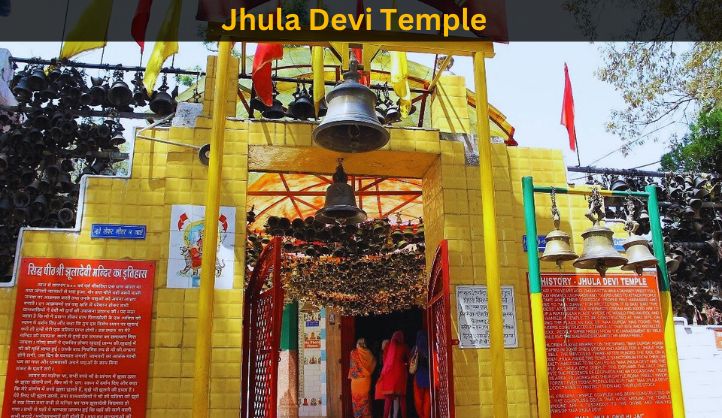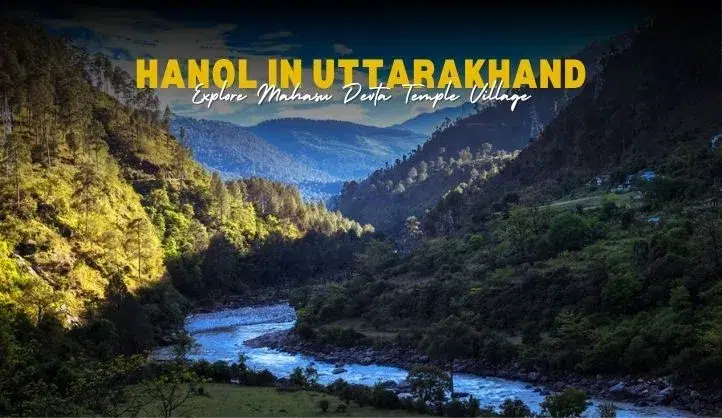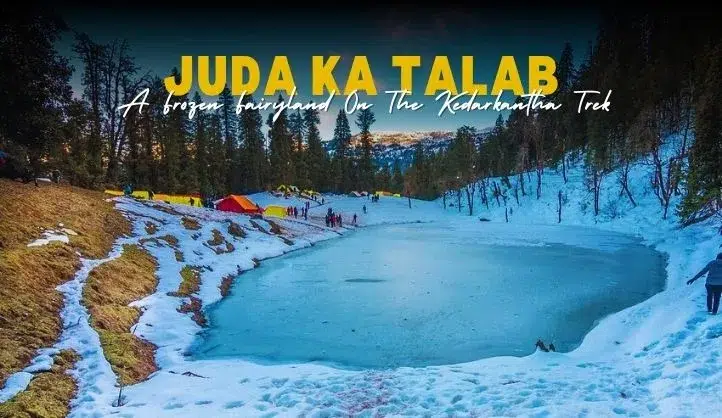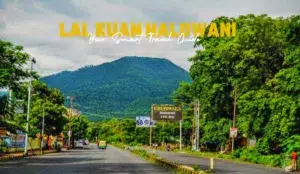Nestled amidst the verdant hills of the Kumaon Himalayas, the Jhula Devi Temple in Ranikhet, Uttarakhand, stands as a beacon of faith and tranquility. Dedicated to Goddess Durga, the temple’s name translates to “Swinging Devi,” reflecting the idol’s depiction of the deity seated on a wooden swing (Jhula). This ancient shrine, believed to be around the 8th century, holds immense significance for devotees seeking divine blessings and a spiritual escape.
A Legacy Steeped in History and Legend
The exact origins of the Jhula Devi Temple remain shrouded in the mists of time. Local lore speaks of a time when the surrounding forests teemed with wild animals, posing a threat to the villagers. The legend recounts the miraculous appearance of Goddess Durga, who established her abode in the serene hills and protected the locals from harm. As a testament to her benevolence, the temple was built, and the tradition of offering bells to the deity began.
While the precise date of construction is unknown, historical records suggest the present temple complex dates back to 1935. Sadly, the original idol was stolen in 1959. However, the devotion of the local populace ensured the temple’s continued significance and a new idol was installed, attracting devotees from far and wide.
How to reach Jhula Devi Temple
By Air
The nearest airport is Pantnagar Airport, which is approximately 109 kilometers away from Ranikhet. From there, you can hire a taxi or use other modes of transportation to reach Ranikhet.
By Train
The nearest railway station to Ranikhet is Kathgodam Railway Station, which is about 75 kilometers away. From Kathgodam, you can hire a taxi or take a bus to reach Ranikhet.
By Road
- From Delhi – Ranikhet is approximately 377 kilometers away from Delhi. You can drive to Ranikhet or take a bus from Delhi to Ranikhet.
- From nearby towns – If you are coming from other towns nearby, you can take buses or hire taxis to reach Ranikhet.
Map of Jhula Devi Temple
The Enchanting Embrace of the Temple
The journey to Jhula Devi Temple itself is a captivating experience. Located approximately 7 kilometers from Ranikhet, amidst the picturesque Chaubatia Gardens, the temple complex offers breathtaking views of the Himalayas. As you approach the temple, the gentle clanging of countless bells hanging on the premises fills the air, creating a symphony of devotion.
The temple architecture is characterized by its traditional Kumaoni style. The main sanctum sanctorum houses the idol of Goddess Durga, adorned with vibrant offerings and flowers. Devotees throng the temple throughout the year, seeking blessings for good health, prosperity, and the fulfillment of wishes.
A Tradition of Bells and Blessings
One of the most distinctive features of the Jhula Devi Temple is the vast collection of bells adorning its premises. It is a tradition for devotees, upon the fulfillment of their wishes, to offer a bell to the Goddess. This practice has resulted in a mesmerizing spectacle – countless bells of various sizes hanging from the temple walls, each one a silent testament to the unwavering faith of the devotees.
A Tapestry of Rituals and Festivals
The Jhula Devi Temple pulsates with life throughout the year. Daily prayers and pujas are performed by the temple priests, while special poojas and rituals are observed during festivals like Durga Puja and Navratri. These festivals witness a surge in devotees, who throng the temple to participate in the vibrant celebrations and seek the divine blessings of Goddess Durga.
A Haven for Nature Lovers
The Jhula Devi Temple’s allure extends beyond its religious significance. The surrounding Chaubatia Gardens, famed for their orchards and mesmerizing natural beauty, offer a haven for nature lovers. Visitors can explore the verdant landscape, indulge in a picnic amidst the scenic surroundings, and soak in the serenity of the Himalayas.
A Beacon of Hope and Harmony
The Jhula Devi Temple serves as a vital center for the local community. It fosters a sense of unity and belonging among the residents, providing a space for them to gather, celebrate, and seek solace in times of need. The temple also plays a crucial role in preserving the rich cultural heritage of the Kumaon region.
Things to do in Jhula Devi Temple Ranikhet
1. Seek Blessings at the Abode of Goddess Durga
The heart of the temple complex lies in offering prayers and participating in rituals dedicated to Goddess Durga. The serene atmosphere within the sanctum sanctorum, adorned with vibrant offerings and flowers, fosters a sense of tranquility and spiritual connection.
2. Witness the Enchanting Tradition of Bells
One of the most distinctive features of Jhula Devi Temple is the mesmerizing collection of bells adorning its premises. Devotees, upon the fulfillment of their wishes, offer bells to the Goddess. This practice has resulted in a spectacular sight – countless bells of various sizes hanging from the temple walls, each one a silent testament to unwavering faith.
3. Immerse Yourself in the Festival Fervor
The Jhula Devi Temple pulsates with vibrant energy throughout the year. Daily prayers and pujas are performed by the temple priests, while special poojas and rituals are observed during festivals like Durga Puja and Navratri. Participating in these celebrations allows you to witness the rich cultural tapestry of the region and experience the collective spirit of devotion.
4. Explore the Alluring Chaubatia Gardens
Nestled amidst the picturesque Chaubatia Gardens, the Jhula Devi Temple offers a delightful opportunity to commune with nature. Explore the verdant expanse of these orchards, famed for their apples, apricots, and peaches. Indulge in a picnic amidst the scenic surroundings, and soak in the serenity of the Himalayas.
5. Capture the Enthralling Beauty
The Jhula Devi Temple complex, nestled amidst the verdant hills and enveloped in the mystical aura of the Himalayas, presents a photographer’s paradise. Capture the intricate details of the temple architecture, the captivating landscape surrounding it, and the heartwarming moments of devotion unfolding within the temple premises.
6. Embrace the Local Culture
The Jhula Devi Temple serves as a vital center for the local Kumaoni community. Interact with the temple staff and local shopkeepers to gain insights into the region’s rich cultural heritage, traditions, and way of life.
7. Savor Local Delicacies
After your enriching visit to the temple, treat yourself to a delightful culinary experience. Explore the local eateries around the temple complex or in Ranikhet to savor the flavors of Kumaoni cuisine.
8. Explore Nearby Attractions
Jhula Devi Temple’s prime location makes it an ideal base to explore other captivating destinations in Ranikhet. Plan a visit to the Kumaon Regimental Centre Museum to delve into the region’s military history, or embark on a scenic trek to nearby hills for breathtaking vistas of the Himalayas.
A Visit for the Discerning Traveler
The Jhula Devi Temple is more than just a religious site; it’s an embodiment of faith, tradition, and the captivating beauty of the Himalayas. Whether you are a devout pilgrim or a curious explorer, the temple offers a unique and enriching experience. The tranquil atmosphere, the vibrant culture, and the breathtaking scenery combine to create an unforgettable sojourn.
Nearby Places to Explore
Beyond the spiritual and cultural richness of Jhula Devi Temple, Ranikhet offers a plethora of captivating destinations waiting to be explored.
Chaubatia Gardens – Nestled amidst the verdant embrace of the Himalayas, Chaubatia Gardens, where Jhula Devi Temple resides, boasts a mesmerizing natural beauty. These sprawling gardens, famed for their orchards brimming with apples, apricots, and peaches, offer a delightful escape into nature’s tranquility.
Kumaon Regimental Centre Museum – Immerse yourself in the region’s illustrious military history with a visit to the Kumaon Regimental Centre Museum. Established in 1928, the museum houses an impressive collection of weapons, uniforms, photographs, and war memorabilia, chronicling the valor and sacrifices of the Kumaon Regiment.
Bhalu Dam – If you’re seeking a serene escape amidst nature, Bhalu Dam, located around 9 kilometers from Jhula Devi Temple, is an ideal destination. Surrounded by verdant hills and enveloped in a tranquil ambiance, this dam offers picturesque views and a chance to enjoy boating activities.
Upat Golf Course – Nestled amidst the captivating Himalayan foothills, Upat Golf Course, established in 1932, is a haven for golf enthusiasts. This 9-hole golf course, sprawled across 60 acres, presents a challenging yet rewarding golfing experience with its undulating greens and breathtaking vistas.
Sun Temple – Embark on a spiritual journey to the Sun Temple, situated around 18 kilometers from Jhula Devi Temple. Dedicated to the Sun God Surya, this ancient temple is believed to have been built during the Katyuri dynasty. The captivating sunrise views and the serene ambiance of the temple make it a worthwhile visit.
Binsar Wildlife Sanctuary – For nature lovers and wildlife enthusiasts, a trip to Binsar Wildlife Sanctuary, nestled around 23 kilometers from Jhula Devi Temple, is a must. This sanctuary, renowned for its diverse flora and fauna, offers a chance to spot a variety of animals like leopards, barking deer, and over 200 species of birds.
Conclusion
The Jhula Devi Temple stands as a testament to the enduring power of faith and the timeless beauty of the Kumaon Himalayas. It’s a place where serenity meets devotion, and where visitors can find solace, inspiration, and a deeper connection with their inner selves. So, on your next adventure to Uttarakhand, make sure to include the Jhula Devi Temple in your itinerary. You might just discover a haven for your soul amidst the majestic mountains.
FAQs about Jhula Devi Temple
What is the significance of the bells at Jhula Devi Temple?
Jhula Devi Temple is known for its unique tradition of offering bells to the Goddess Durga. Devotees, upon the fulfillment of their wishes, present bells of various sizes, which are then hung within the temple complex. This practice has resulted in a mesmerizing spectacle, symbolizing the unwavering faith of devotees.
2. What festivals are celebrated at Jhula Devi Temple?
The temple pulsates with life throughout the year, with daily prayers and pujas. However, special poojas and rituals are observed during major Hindu festivals like Durga Puja and Navratri. These festivals witness a surge in devotees who participate in the vibrant celebrations and seek blessings from the Goddess.
3. How can I reach Jhula Devi Temple?
- By car – Hire a taxi or cab for the most convenient option. The ride takes approximately 15-20 minutes, covering a distance of around 7 kilometers.
- By bus – Regular buses ply between Ranikhet and Chaubatia Gardens, where the temple is located. This is a more economical option but may take longer depending on the schedule.
4. What are some things to do near Jhula Devi Temple?
Beyond the temple itself, Ranikhet offers a variety of attractions to explore:
- Chaubatia Gardens – Explore these picturesque gardens renowned for their orchards and breathtaking Himalayan views.
- Kumaon Regimental Centre Museum – Delve into the region’s military history at this museum showcasing war memorabilia and artifacts.
- Bhalu Dam – Enjoy a tranquil escape amidst nature and serene beauty at this dam, offering boating activities.
5. What is the best time to visit Jhula Devi Temple?
Ranikhet experiences pleasant weather throughout the year. However, the most comfortable time to visit Jhula Devi Temple is during the spring season (March to May) and autumn season (September to November). These months offer comfortable temperatures and captivating scenic beauty.









